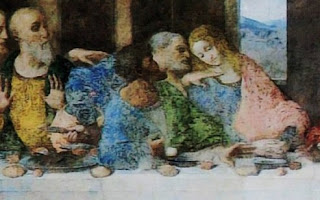John the Assassin II
... more to come.
The hand now on John's shoulder is no longer consoling him, it is arresting ... as is the right. But now there are three pictures there. Because he is consoling the angelic John. But then, no he is holding him back from slaying the betrayer. The angel in John's face becomes disappointment, utter disappointment at having failed to kill him. The angel in John's face didn't think twice about pulling the knife. And then there is the knife and the arm, extended behind Judas' back, it is the image of a spear piercing the body. And then Peter's hands again, because this time I notice they form a sort of cross behind Judas' back, and that pose Judas has, is almost prone, and so there is this third image of a body, pierced, being lowered from a cross...
... am I mad to think these things?
The book was Javier Sierra's The Secret Supper. Though the book never goes near my epiphany here, it nevertheless is arguing the same arguement: that the papacy (and its reflection of Peter) was repellent to DaVinci and the Duke of Milan - and that in fact there was a separate sect, the followers of John, that have been lost to history, but perhaps not to DaVinci, nor the Duke of Milan. There are many other observations about the painting. DaVinci himself is having a coversation with Plato on the very right of the picture...
Whether the world and Wikipedia will ever agree with me, well, perhaps is a question for the ages. I generally think that maybe my theory can be proved by measurement. By measuring the distance between John's shoulder and the knife and comparing it to the, well, other pictures that Leonardo painted, well, perhaps it would would prove out....
For the moment at least, I am without doubt....
First, is the 'crook' in Peters arm. It is there without question. The line of the forearm is into the shadow that is behind Judas's back, and not at all towards the wrist that is in the light, bearing the hand, bearing the knife. But far beyond this, I think the symbolism of light vs. dark that is pervasive thoughout the picture bears my theory out. The light of Jesus shines brightly on John's face. There is virtually no shadow there. At first glance this appears to be also the case with Peter's face, or at least the side of his head is in the light, but on closer observation it is obvious John is casting a shadow on Peter's face. Judas's face has no light at all, either because it cannot capture the light that is in the center with Jesus, or perhaps it is shaded by both or either John or Peter... The position of Peter behind Judas' back is also symbolic. Again this runs into Javier Sierra's theme, and I am not sure how anyone could dismiss this symbolism; for would not Judas cast a shadow on that which is behind him? Which leads me back to the arm, or the the arms: the right hands of both John and Peter, one dark, one light crossed against each other...

